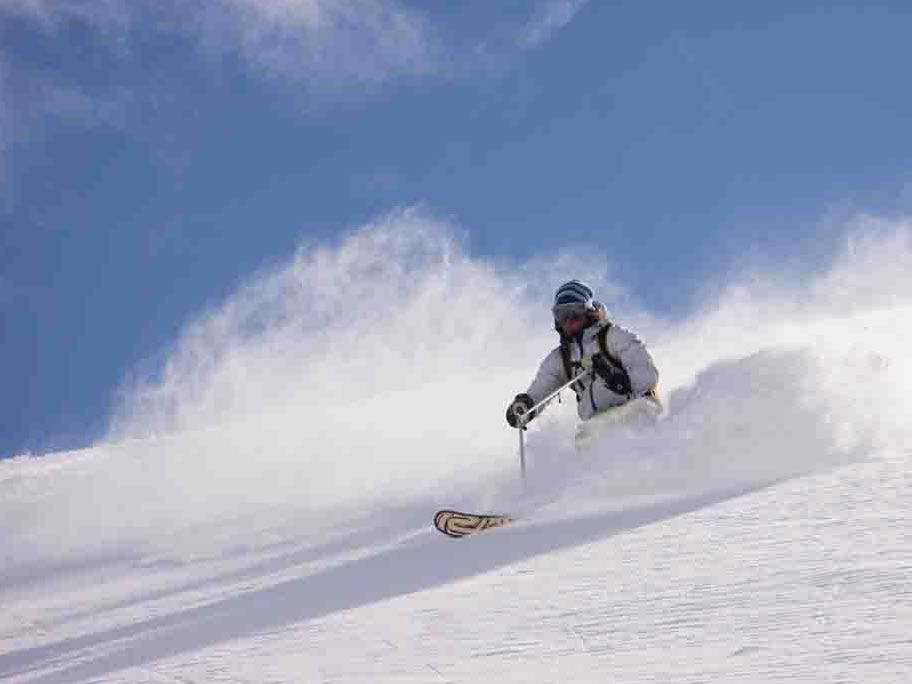Free the heel and the mind shall follow.
This is the mentality of a telemark skier. With the added mobility and flexibility of their equipment, the telemarker has a heightened awareness of balance, movement and their centre of gravity.
There are few skiers who chose the path of Free Heel these days, but the newly formed BC Telemark Ski Association (BCTSA) intends to reinvigorate the sport locally by hosting the Whistler Telemark Festival this Saturday, Feb. 4.
The festival will offer coaching from Whistler Blackcomb instructors certified by the Canadian Association of Nordic Ski Instructors (CANSI), steeps and backcountry skills sessions, racing clinics and freestyle and freeride competitions with prizes. Helmets are mandatory for clinics and all ages and abilities of skiers are encouraged to try a day of "tele."
Riding the chairlifts in Whistler you will occasionally notice a skier, unusually low to the ground, one ski trailing behind the other. What you may not know is this was the original skiing turn, named after the Telemark region in Norway, where it was invented by skiing pioneer Sondre Norheim. The turn involves the skier leading with the outside ski and dropping (flexing) the inside knee, thus drawing the inside ski under the body. The turn itself is harder than it sounds, requiring significantly more strength in the skier's quadriceps and a more difficult management of the skier's centre of gravity.
While modern telemarkers tend to use the same skis as their alpine cousins, the similarities in equipment end there. Telemark bindings only attach at the toe of the boot (via a plastic tab known as a "duckbill") with the heel being secured by spring-loaded cables. The boots are generally lighter and are made of more flexible pebax plastic found in lighter alpine touring (AT) boots. Telemark boots also have bellows near the toe to allow the flexibility needed in lifting the heel.
The reduced weight and touring capability of telemark equipment made it the tool of choice for backcountry skiers for decades, however the lack of sturdiness meant skiers were not able to ski overly aggressive lines.
"Racing is what evolved the equipment," said Pique columnist and author Leslie Anthony, who spent several years racing telemark on the world circuit.
"People were blowing up boots, bindings, skis so often that really the bindings had to get better, the skis had to get bigger and the boots had to get stiffer. We were making stiff boots by bolting pieces of restaurant bucket plastic onto the back of leather boots to make them work better. And this was in the mid '80s."
But like in any international ski racing discipline, once the governing body got hold of the rule book it began to regulate every detail and dimension of the telemark racing equipment. Innovation from racing slowed, but backcountry skiers now had the tools needed to ski real mountains. Freeride telemarking evolved the equipment further, adapting first to the shaped ski and later to fat skis and rocker technology. Recent advances in telemark technology have made boots even stiffer and now feature a releasable binding, which has added an element of safety at high speeds, safety needed in organized telemark racing.
Shane Landreville is the President of BC Telemark Association and races on the FIS Telemark World Cup circuit including both GS (like a regular alpine giant slalom course but with telemark turns) and classic events.
"It incorporates all of skiing," said Landreville when describing the classic event.
"You have the jumps, you have the gate turns and you have the skating sections so it brings skiing all together into one really exciting discipline to race as a competitor as well as being an enjoyable spectator event."
The jump adds a thrill to the classic, with racers having to clear a distance line (usually between 25-40m) and land in telemark position to avoid having points deducted. The course also includes a unique 360 degree berm to slow down competitors before the skating section, where the athletes must challenge their aerobic capacity for up to two minutes on flat or uphill terrain.
While there will not be a classic race held in Whistler on Saturday, BC Telemark is organizing the Fernie Freeheel Weekend in March, which will feature a classic course and a tele-cross race, with telemarkers racing head to head down a ski cross course.
Racing is, of course, just one end of the telemark spectrum, the soul of the sport remains in its ability to open skiers to new possibilities in the mountains.
"Telemark is a lifestyle," said Landreville.
"You'll hear the quote 'free the heel, free the mind' and as cliché as it sounds, it really holds true to what telemark is. You're freeing up your equipment and getting more range of motion in your equipment.
"It gives so much back, whether its competing or going into the backcountry ski touring. It's so diverse."
The Whistler Telemark Festival takes place on Saturday, Feb. 4 on Blackcomb. Entry costs $10 including membership to BCTSA for future events. For more information go to bctelemark.com




